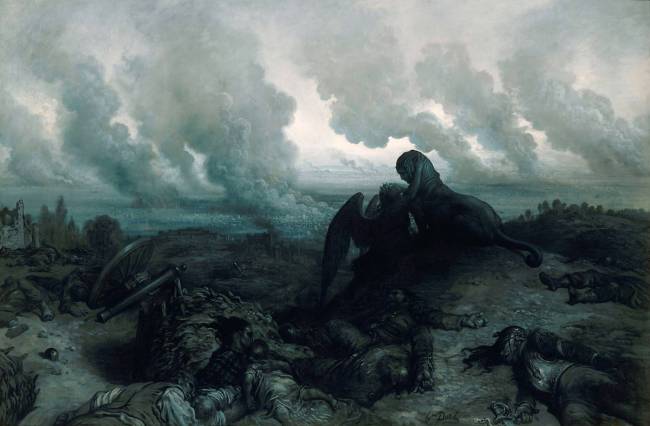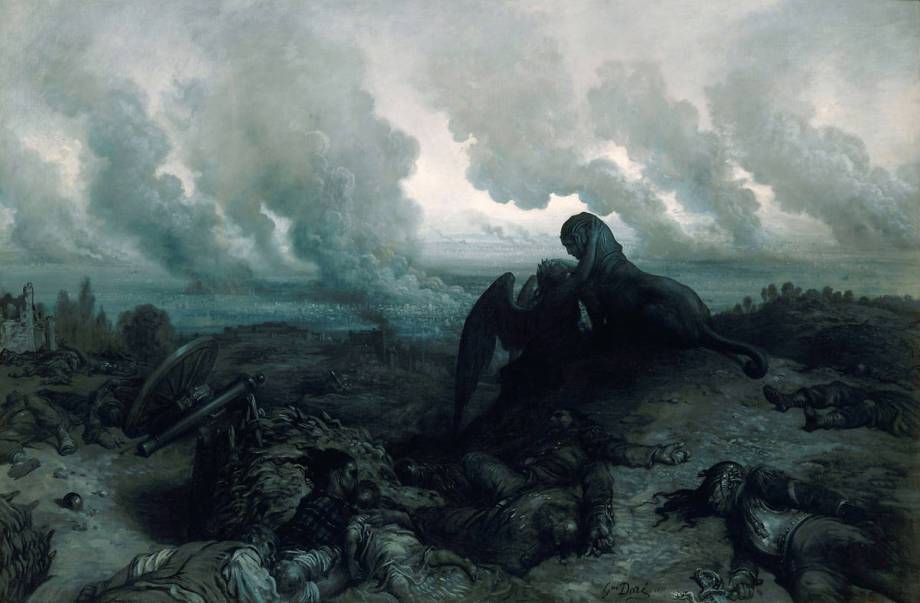Shop art print and framed art The Enigma by Gustave Doré
Customise
Your art print
The Enigma OF Gustave Doré
The Enigma
L'Énigme by Gustave Doré: An allegorical vision of defeat
L'Énigme, painted in 1871 by Gustave Doré, is a work deeply marked by the French defeat by Prussia and the loss of Alsace-Lorraine, the artist's native land. This quasi-monochrome painting in shades of grey and blue, now in the Musée d'Orsay in Paris, measures 196 x 130 cm and is accompanied by two poignant verses by Victor Hugo, no doubt chosen by the painter himself, from the poem "À l'Arc de triomphe":
"O spectacle! so dies that which the peoples do!
That such a past for the soul is a deep abyss!"
These verses underline the dismay and incomprehension in the face of the violence and destruction wrought by war, questioning the very meaning of these conflicts.
Visual composition of l'Énigme and allegory of Gustave Doré's feelings during the war
The Enigma presents a striking composition, where the desolate landscape and allegorical figures mingle to create a tragic atmosphere. In the foreground, a pile of soldiers' corpses lies on the ground, testifying to the brutality of the fighting. Atop this macabre hill, a monumental sphinx, a hybrid mythological creature with the body of a lion and the head of a woman, dominates the scene. At its feet, the Angel of Humanity stares down in grief. His stare expresses his questioning in the face of the absurdity of war. In the background, a burning city, probably Paris under siege, symbolises destruction and chaos. The dark, cloudy sky reinforces the impression of desolation and sadness emanating from the work.
The Sphinx: Central and enigmatic figure of The Enigma
The Sphinx, the central figure in the composition, embodies the enigma evoked in the painting's title. A guardian of mysteries and a symbol of wisdom in Greek mythology, he poses a fundamental question here: what is the meaning of this war? Why so much suffering and loss? His compassionate gaze towards the angel expresses his powerlessness in the face of human folly. The sphinx thus becomes Doré's spokesman, expressing his dismay and incomprehension at the tragedy that has struck his country.
Impact and posterity of Gustave Doré's l'Énigme
L'Énigme is a major work in Gustave Doré's career, testifying to his commitment and sensitivity to the events of his time. The painting left a lasting impression through its expressive power and allegorical dimension, prompting reflection on war and its consequences. Today it remains a poignant symbol of the tragedy of the 1870 defeat and of the quest for meaning in the face of violence and destruction. L'Énigme also helps to reinforce Doré's reputation as a committed artist, capable of translating the emotions and questionings of his time through universal works.
This artwork is a painting from the modern period. It belongs to the romanticism style.
« The Enigma » is kept at Musee d'Orsay, Paris, France.
Find the full description of The Enigma by Gustave Doré on Wikipedia.



































